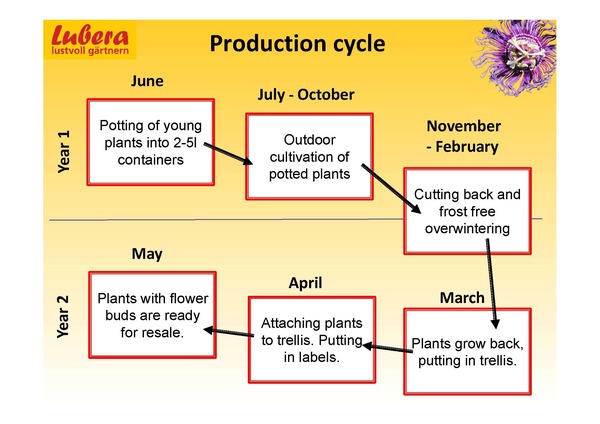The Passiflora incarnata hybrids in the Cooltropics® series ('Eia Popeia' and 'Snowstar') are easy to cultivate and can be sold in different sizes. In fact, the climbing plants are very easy to care for and quite robust. With appropriate fertilization and watering, they grow quickly and quickly present their full splendour.

Cultivation in large pots: increasing value through size and flowering
The main production method for hardy passion fruit is similar to that for clematis. The edible climbing plants are cultivated in larger containers (2 to 5 liters) over the course of a year.
- This procedure typically starts after the spring rush, in June to July, by potting the Cooltropics® Passiflora young plants directly into their final pots (C2, C3 or C5).
- The potted, hardy passion fruit plants are now cultivated outdoors, in a plastic tunnel or greenhouse until late fall. Here the passion flowers can and should grow wild and do not need tying up, pruning or other labor-intensive care measures. The pots should not be too cramped to ensure healthy growth. A strong emphasis on good fertilization and watering promotes strong root growth.
- The passion fruit plants can be moved indoors in November. Before wintering, the foliage is cut back to just above the ground and the plants are kept cold (0°C) but frost-free over winter.
- To stimulate root activity in March and bring the plants out of their winter dormancy, a brief increase in temperature to warm-house level is beneficial. A few sunny days in the greenhouse are often enough to support this process. Growth can be excellently controlled by regulating the temperature: At 15 °C, Passiflora incarnata is largely dormant, whereas at 25 °C it shows rapid growth.
- The newly sprouting plants are staked at the end of March and the shoots are tied to the climbing frame in April and May.
- Prepared in this way, the plants can be offered for sale at the end of May, rich in flowers and buds, alongside other climbing plants such as clematis. The possible sales period then extends until the beginning of fall in September. Depending on the time of sale, the plants may need to be pruned back once. A slightly later sales period allows premium products, i.e. Cooltropics® passion fruit with flowers and fruit, to be marketed at a higher price.
This cultivation method is particularly recommended for companies that already have experience in cultivating climbing plants and are aiming for a higher-quality product.

Cultivation in small pots: a quick product for spring
An alternative to the rather long production cycle in large containers is to produce Cooltropics® passion flowers in a small pot in just 2-3 months.
- The Cooltropics® Passiflora incarnata young plants are potted in 10.5 cm or 12 cm pots in February or March.
- The fruit plants are then produced under warm conditions in a similar way to tomato, cucumber or chili plants. This means that the plants are staked only a few weeks after potting. This method shortens the cultivation period and simplifies cultivation, as the passion fruit plants can be treated similarly to other fruiting vegetables.
- A sales launch from the end of April at the earliest, together with other heat-loving fruit vegetables, is a good idea. Such an approach enables integration into a range of unusual fruit plants, such as physalis or melons, and can help to diversify the range.
However, possible disadvantages should be considered: The lower sales prices and selling at a time when there is already a big rush and production capacities are scarce. In addition, the plants are still smaller and without flowers at this stage. Despite all this, it can be a worthwhile alternative for smaller companies, as a shorter production cycle is easier to integrate into existing plant production processes.
